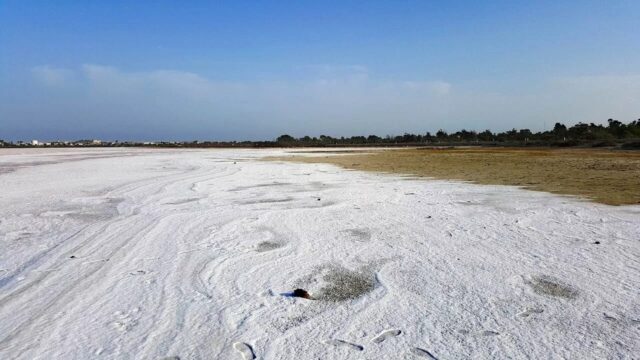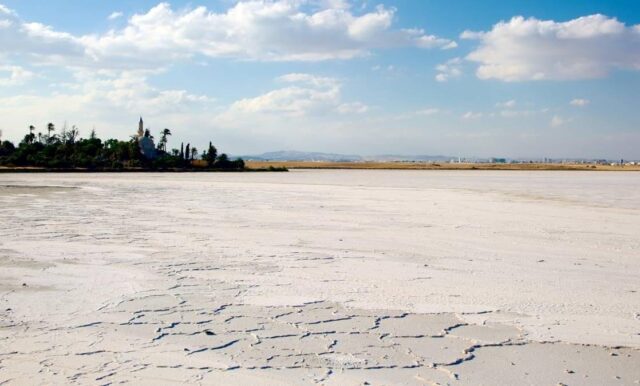Akrotiri Salt Lake is the largest natural lake in Cyprus and one of the most significant wildlife habitats in the Eastern Mediterranean. Located in the southern part of the island, near the city of Limassol, the lake is a unique ecosystem that combines natural beauty, rare flora and fauna, and a centuries-old history of interaction between humans and nature.

Contents
- 1 Geographical location and general information
- 2 Origin and geological features
- 3 Climate and seasonal changes
- 4 Ecosystem and importance for wildlife
- 5 Historical significance and uses of salt
- 6 Monastery of Saint Nicholas of Akrotiri
- 7 Center for Environmental Education
- 8 Tourism and visiting rules
- 9 Legends and cultural associations
- 10 Significance for science and international cooperation
Geographical location and general information
The Akrotiri Salt Lake is located on the Akrotiri Peninsula, approximately 10 kilometers west of Limassol. Its surface area varies between 10 and 15 square kilometers depending on the season, and its depth rarely exceeds one meter. During the rainy season, the lake fills with water, but in the summer it dries up almost completely, turning into a snow-white salt flat.
The Akrotiri area is part of the British Sovereign Base Area, but is protected by Cypriot and international conservation organizations. The lake has been designated a Ramsar Wetland of International Importance and is part of the European Natura 2000 program.
Origin and geological features
The Akrotiri salt lake was formed approximately 10,000 years ago as a result of natural processes such as soil subsidence and the separation of a saltwater lagoon from the open sea. Gradually, the lagoon became a closed body of water, into which rainwater and groundwater, rich in minerals, flowed.
The lake’s mineral composition determines its salinity—during droughts, the salt concentration is several times higher than that of seawater. In summer, the surface of the lake becomes covered with a dense crust of crystallized salt, creating the impression of a snowfield shimmering in the sun.
Climate and seasonal changes
Lake Akrotiri is subject to sharp seasonal fluctuations. From November to March, it is filled with water from winter rains and underground springs. In the spring, the water level gradually decreases, and by June, the lake often turns into a flat salt marsh plateau.
These changes create unique conditions for the lives of dozens of species of birds, plants, and microorganisms adapted to the salty environment. During periods of high water, the lake becomes a mirror, reflecting the sky and the Troodos Mountains, and in summer, it transforms into an endless white plain swept by a hot wind.

Ecosystem and importance for wildlife
Lake Akrotiri is considered the largest natural ornithological area in Cyprus. More than 300 bird species have been recorded here, including rare and endangered species.
The lake is best known for its pink flamingos, which stop here annually during their migration from Africa to Europe. In some years, the number of birds reaches tens of thousands, creating a breathtaking spectacle.

Besides flamingos, the lake is home to herons, pelicans, swans, waders, ducks, and cormorants. Akrotiri serves as an important staging post for migratory birds on their journeys between continents, providing them with food and rest.
Salt-resistant plants, such as sarsaparilla, sea lavender, saltwort, and reeds, grow around the pond. They play a key role in preserving the ecosystem, preventing soil erosion and maintaining moisture balance.
Historical significance and uses of salt
The exploitation of Akrotiri’s salt resources began in ancient times. Archaeological finds indicate that even in ancient times, local residents mined salt here, which was considered a valuable trade commodity.
Until the mid-20th century, small saltworks operated on the lake, where salt was harvested by hand after the water evaporated. This industry provided food for residents of the coastal villages, and the products were exported.
Over time, industrial mining ceased to preserve the natural balance, but the memory of the “salt era” was preserved in the names and legends of local residents.
Monastery of Saint Nicholas of Akrotiri
On the northeastern edge of the lake stands the Monastery of St. Nicholas of Akrotiri, built in the 13th century and rebuilt several times in subsequent centuries. The monastery is the spiritual and historical center of the region.
Nearby, archaeological remains of an older church dating back to the early Christian period remain. The monastery gardens offer panoramic views of the entire lake, especially beautiful in the winter months, when the water’s surface reflects the sunset sky.

Center for Environmental Education
In 2013, the Akrotiri Environmental Education Centre was opened on the peninsula, which is engaged in scientific research and environmental education.
Here you can visit an interactive exhibition dedicated to the lake’s flora, fauna, and ecology, and also enjoy birdwatching from equipped observation platforms. The center collaborates with the British military base and Cypriot conservation organizations, combining efforts to preserve the region’s ecosystem.
Lake Akrotiri is subject to ongoing environmental monitoring. Studies are conducted on water quality, bird migration patterns, and vegetation status. The main threats are climate change, drainage, and urbanization in the surrounding area.
To protect the natural balance, programs are being implemented to restore wetlands and regulate water flow. The lake has a special legal status, which restricts construction and agricultural activities in the surrounding areas.
Tourism and visiting rules
Lake Akrotiri is one of the most popular ecotourism destinations in Cyprus. It is especially popular with photographers and birdwatchers. The best time to visit is from November to March, when flamingos and other migratory species gather on the lake.
For visitors’ convenience, wooden paths and observation platforms have been installed, allowing them to observe the birds without disturbing their peace. Access to the area is regulated: approaching the bird colonies, driving on the dry bottom, and leaving litter are prohibited.
Legends and cultural associations
Local legends link the lake to biblical events and ancient miracles. According to tradition, pilgrims on their way to the Holy Land stopped here. Folk tales refer to the lake as a “mirror of the sun,” reflecting the travelers’ destinies.
For modern Cypriots, Akrotiri has become a symbol of natural harmony and beauty, the embodiment of tranquility and human connection with the surrounding world.
Significance for science and international cooperation
Lake Akrotiri is a key scientific site for ornithologists and ecologists. International bird migration monitoring programs are conducted here, and the impact of saltwater ecosystems on the region’s climate and biodiversity is studied.
The research results are regularly published in scientific journals, and monitoring data is used to predict bird migration routes throughout the Mediterranean.
Akrotiri Salt Lake is a natural treasure of Cyprus, where science, history, and beauty merge. It plays a key role in the island’s ecosystem, providing a haven for thousands of birds and maintaining the balance between sea and land.
A visit to this place is an opportunity to witness the unique harmony of nature, feel the breath of the earth, and realize how fragile the world of living beings is. Akrotiri remains a reminder that even in the modern world, there are places where nature speaks louder than man.

















